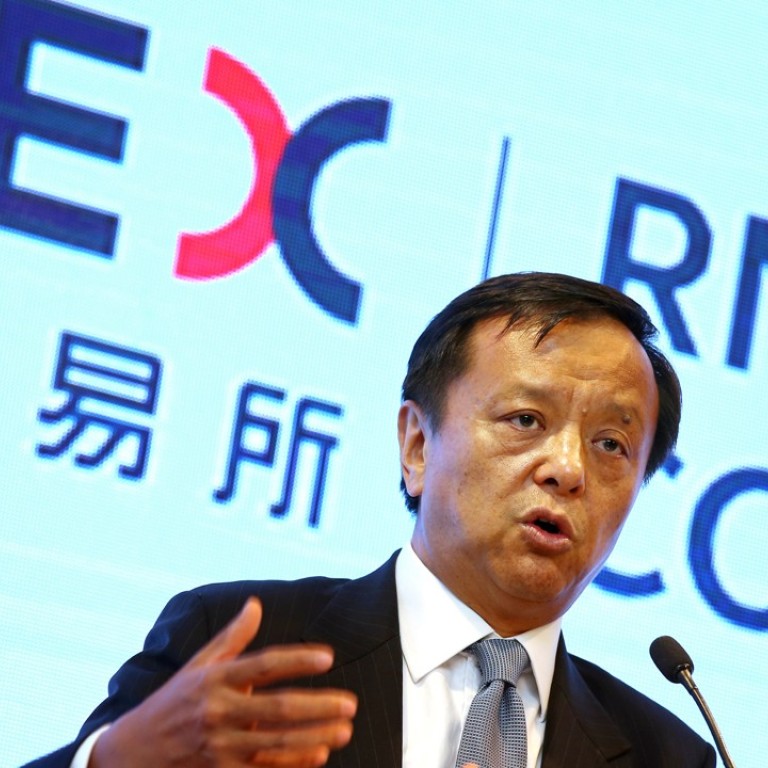
Rising bond yields, planned Connect scheme and stabilised yuan will all help lure more international investors
Yields on China’s onshore market have risen back to their levels of late 2014, driven by the rebound in inflation and commodity prices in November and December
Higher yields, easing currency concerns, and further opening up of the domestic market are likely to prompt rising investment into China’s US$9 trillion onshore market by foreign investors in the coming months, according to analysts.
Bond yields on China’s onshore market have risen back to their levels of late 2014, driven by the rebound in inflation and commodity prices in November and December, and accelerated since March as interbank rates surged and the regulator cracked down on arbitrage and risky lending practises.
Yields on benchmark 10-year Chinese government bonds is now up about 100 basis points to above 3.65 per cent from its low in late October, and corporate bond yields are on average up by about 200 basis points.
Onshore Chinese yuan, meanwhile, has touched its highest level at above 6.75 yuan against the US dollar in nearly seven months, after China’s central bank set the yuan midpoint at the strongest point since November, in a strong show of force against short sellers.
“Yuan bears will either go into hibernation or take to the sidelines licking their wounds for the foreseeable future,” said Stephen Innes, senior trader at Oanda.
While both corporate and government bond yields are at their highest since 2014, Chen Long, China economist at Gavekal Dragonomics, says the sell off is not over yet, and neither is the financial crackdown.

“Bad news for sellers of bonds could be good news for buyers of them. The recent rise in yields could well make the onshore bond market attractive for investors who believe the country is still headed for a structural slowdown in growth and inflation in coming years,” Chen wrote in a research note on Tuesday.
“China’s sovereign and quasi-sovereign bonds could be a great longer-term macro trade if their yields decline over time along with economic growth – a trajectory that both Japan and South Korea have followed,” he added.
Moody’s downgraded Chinese government bonds from A1 to Aa3 on Wednesday on long-standing concerns about declining potential growth and rising economy-wide debt, but managed to upgrade China’s outlook to stable from negative.
“While lower growth and rising debt may not be good for China, they can be quite good news for fixed-income investors, especially in a market where most sovereign debt is in local currency and most of the players are domestic,” Chen wrote in the note.
“Japan also suffered from declining growth, rising debt, and multiple downgrades by international ratings agencies – but Japanese government bonds have been a fantastic investment, with yields declining steadily over the past 15 years. Foreign investors now own 10 per cent of the Japanese government bond market.”
Foreign investors reduced their holdings of Chinese onshore bonds in late 2015 and early 2016, and they now stand at 802 billion yuan (US$117 billion), accounting for 1.6 per cent of the market, a ratio that has not changed much over the past year as the market itself expanded rapidly.
One of foreign asset managers’ biggest concerns about China over the past 18 months has been the tightening up of capital controls... The Bond Connect programme should ease some of those worries
Investment wise, Chen said the formal announcement of Hong Kong’s planned Bond Connect scheme between Hong Kong and the mainland , which it is hoped will attract more international investors to trade on China’s onshore bond market, free of quotas, should help the market expand.
“One of foreign asset managers’ biggest concerns about China over the past 18 months has been the tightening up of capital controls. The Bond Connect programme should ease some of those worries, as Hong Kong’s commitment to free capital mobility has great credibility, and the free operation of the two Stock Connect programmes [between Shanghai and Shenzhen, and Hong Kong] has set a good precedent,” he wrote in the note.
According to Goldman Sachs’ analysis, China bonds could account for 10 per cent of emerging market benchmark indices, and 6 per cent of global benchmarks by 2021.
“Bond inclusions are more likely to start materialising in 2018, with the JP Morgan’s Government Bond Index-Emerging Markets index potentially kicking off the globalisation process of China bonds, followed by Bloomberg Barclays Global Aggregate and Citi’s WGBI by 2019-2020,” said Goldman Sachs.
The inclusion into global bond indices will attract US$250 billion of inflows to China’s bond market over the next five years, the report predicts.
However, there are still some unfavourable issues facing China’s onshore debt market, which are keeping international index providers from including China in the benchmarks, the report said.
The first concern comes from registration, or market access.
“There are several steps, forms and requirements that are needed to register for the China interbank bond market (CIBM) and the process may take several months for some investors.
“Feedback from investors suggests they would like a more streamlined process, applications in one place, filling in a single form, and a faster turnaround time from the agent banks and authorities involved in CIBM registration,” the report said.
While the CIBM rules do not restrict repatriation, many investors say they were also worried about the likely continued existence of “soft” capital controls, especially when outflow pressure is high, the report noted.
Other concerns include market liquidity and settlement cycle.

